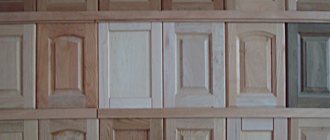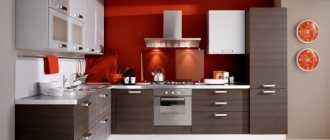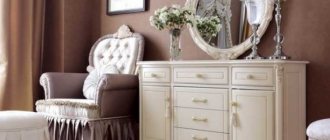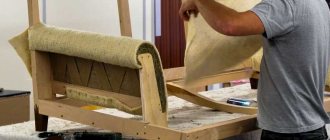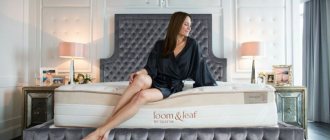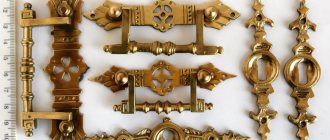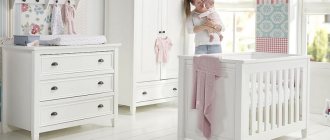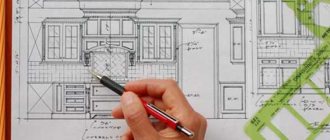When choosing a kitchen set, we strive to obtain not only attractive-looking furniture, but also high-quality furniture that is safe for all family members. Nowadays a wide variety of materials and technologies are used, but classic MDF kitchens remain popular.
We will try to explain to you what the features of the raw materials used in production are, as well as the advantages and disadvantages of this solution.
Features of the material
Fine sawdust is used to make this type of furniture. In order to glue the material together, lignin and paraffin are used, and then the raw material is subjected to high pressure. The result is slabs of a given size. All components are characterized by environmental safety and harmlessness to humans. They do not have toxic effects when heated or temperature changes.
But chipboard, unlike MDF, is a less safe material, since formaldehyde resins are used in production. When the top layer of the slab is destroyed, harmful substances can be released into the air.
Therefore, when making, for example, kitchen countertops, a safer solution is required. The solution is the combined use of materials - the base is made from high-quality chipboard, and the facade is made from MDF.
Three types of MDF boards can be used to make furniture:
- solidly pressed panels with a high level of heat and sound insulation, an average level of moisture resistance;
- laminated boards - they are resistant to mechanical damage due to their greater density and hardness, and are also able to withstand the effects of moisture and harmful substances;
- moisture-resistant material - a dense structure that can withstand increased loads and the action of hot condensate, moisture-resistant.
When making kitchen furniture, preference is given to the last two types of panels, which better withstand high humidity and high temperatures.
Chipboard and laminated chipboard
This abbreviation stands for particle board. From the name of the product it is easy to guess what it is made of. This is shavings. It is pressed after being mixed with formaldehyde resin. The entire process takes place at a high surface heating temperature. Under the pressing machine, the chipboard sheet is kept for the required time, after which it is laid out on a flat surface to cool. Once the sheet has cooled, it is ready to use. This is chipboard, but it is not yet ready for installation in the kitchen. It needs to be laminated. The lamination process uses several technologies.
- Postforming (plastic sticker).
Lamination process using postforming technology
2. Sticker of craft paper, impregnated and steamed.
Kraft paper sticker on table top
3. Lamination with melamine paper.
Melamine paper used for table tops
Postforming is the most modern method of finishing chipboard sheets. The most durable surface is obtained using this technology. This type of countertop doesn’t care about moisture. Even if damaged, scratched or other minor deformation, water will not damage the integrity of the coating.
Postforming is the most modern method of finishing chipboard sheets
Classic laminated chipboard is made using lamination technology with paper impregnated with melamine resin. The prefix “L” means “laminated”. Chipboard is rarely used in the kitchen. Wear resistance and durability are not a strong point here.
This is what the chipboard lamination process looks like
See alsoTypes of hobs for the kitchen
Advantages and disadvantages of MDF kitchens
The variety of materials used in the production of furniture sets provides customers with a wide choice. But you should remember some advantages of MDF:
Kitchen sets made from this material are more affordable compared to, for example, solid wood. Combined use with chipboard also helps to reduce the cost of production. Therefore, you can easily choose an option that suits your budget.
Attractive appearance, for which decoration is carried out using plastic, film or enamel. So, you can get beautiful glossy or matte surfaces. And MDF with photo printing, thanks to a variety of patterns, will definitely enliven the interior.
High performance properties - withstands mechanical loads and moisture.
Features of caring for a glossy kitchen
Many owners are interested in the question of how to wash a glossy kitchen in order to maintain its impeccable appearance.
For daily care, it is recommended to use a soft, damp cloth such as microfiber or cotton. To remove old stains, you can use a soap solution and gentle dishwashing detergents. The use of abrasive and aggressive cleaners is not allowed.
To remove stains and quickly add shine to furniture, you can use an alcohol-based glass cleaner - just apply a small amount of the product to the facade and wipe dry with a soft towel.
Easy to care for
Often when furnishing a kitchen, an apron made from MDF is used. It is cheaper than tile, easy to install and can be decorated in a variety of ways. At the same time, you should remember the disadvantages of this type of kitchen furniture:
- burning out of the finishing layer under the influence of ultraviolet radiation;
- peeling of the film, especially in places near heat sources;
- scratches appear when cleaning.
If a manufacturer skimps on quality and uses low-grade adhesives, the slabs can swell and become deformed. Therefore, choose only proven brands and models.
Types of glossy facades and their features
Kitchen facades with a glossy surface can differ in the method of applying the gloss: PVC film, acrylic, varnish, paint and plastic. Depending on the material used, they differ in their characteristics.
In this section we will analyze in order all the pros and cons of existing varieties of glossy surfaces according to the method of applying them to facades.
Glossy coating can be made on the basis of plastic, PVC film, paint and acrylic
Postforming (plastic)
Perhaps this is the most budget option for glossy facades. To consolidate the result, the postmorphing method is used - increasing temperature and pressure.
On the front side, the plastic is curved onto the side parts of the facade, which ensures high resistance of the coating to chemical, thermal and mechanical influences. The reverse side of the facade is also lined with plastic to match the color, but matte.
The main advantage of plastic is its low price and waterproofness.
Advantages . This is a 100% waterproof material that impresses with its budget price. Resistant to temperature changes and aggressive detergents. It has a wide range of colors, which allows you to choose the right option for any kitchen.
Flaws . Low resistance to color loss compared to other methods of façade cladding. Domestic damage, scratches and other minor defects resulting from use cannot be corrected.
Over the years, plastic loses its original color
When purchasing, you should take into account that MDF kitchen facades can be ordered to any standard size. But models based on chipboard are made only to fit standard ones.
PVC film
The facades are covered with PVC film using hot vacuum pressing technology on special membrane-vacuum presses. This type of facade can also be classified as an economical option.
PVC film is easy to care for and comes in a huge range of colors
Advantages . PVC film is easy to care for and has a wide range of different textures. Its price will not hit the family budget as much as more durable materials.
Flaws . If the film is not of sufficient quality, due to exposure to high temperatures and high humidity, it will begin to peel off from the base.
Exposure to high temperatures may cause the film to peel off
Painted facades
This type of kitchen facade can already be attributed to the middle or higher price segment. Instructions for applying gloss are as follows:
- Preliminary preparation of the MDF board is carried out (sanding and priming).
- Several layers of paint are applied. Each layer is thoroughly dried and sanded.
- Several layers of varnish are applied.
- Polishing is in progress.
Deep color coating is achieved by applying several layers of paint and varnish
The result of such careful work is a perfectly smooth glossy surface of excellent quality and excellent decorative qualities.
Painted glossy surfaces are not subject to peeling
Advantages . Just a huge range of colors and shades (up to 1000). The glossy surface achieved by painting does not warp or peel. This coating is not afraid of temperature changes and humidity.
Flaws . To reduce the cost of such a facade, its reverse side is most often made simply white. The surface is highly susceptible to mechanical damage (chips and scratches).
Due to mechanical stress, chips may occur on the painted surface.
Acrylic coating
Over the past few years, acrylic gloss has become in much greater demand. MDF boards, onto which acrylic glossy plastic is applied using polyurethane glue, look incomparable and also have very attractive aesthetic and technical properties.
Acrylic gloss is resistant to moisture and high temperatures
Advantages. The gloss achieved in this way is resistant to moisture and color loss. During operation, you don’t have to worry about possible damage, since all defects on the acrylic glossy surface can be easily eliminated by polishing yourself.
Flaws . When caring for acrylic glossy surfaces, do not use aggressive detergents. It is impossible to make a radius facade from acrylic, only a blank one.
Do not use aggressive detergents to clean acrylic.
Kitchens made of painted material
Headsets made using this technology are aesthetically attractive and are characterized by a variety of color palettes. In particular, original decoration can be achieved by painting the facade with gradient transitions, by giving the furniture a chameleon effect.
To make a painted set, automotive enamel is applied to the surface in several layers. The resulting color is bright and rich.
Enamel is suitable for any surface. At the same time, from the front side the plate can be glossy or matte. It is also possible to apply a design using milling.
Sofa for the kitchen - choosing a practical, functional and stylish interior element (95 photos)Beige kitchen - suitable combinations of colors and materials. 110 photos of optimal ideas for 2020
- Green kitchen - great design ideas for modern and retro styles (90 photos)
The material has excellent performance properties. It does not require much effort when cleaning - just gently wipe with a sponge with water and a cleaning solution. The glossy surface may retain traces of touch. In addition, there are scratches on it.
Glossy kitchen fronts - features
The degree of gloss determines the amount of reflected light. The norm is considered to be from 90 to 98%.
A distinctive property of such products is the effect of visually increasing space.
A glossy kitchen set has other advantages.
- Improves lighting.
- Easy to clean, although dirt appears quite quickly.
- The products are presented in a wide color palette.
- Do not lose their original color for a long time.
This finish is suitable for a small kitchen, as it will visually expand its boundaries.
Gloss should be chosen when combining a kitchen space and a living room or for a studio apartment. Furniture in this situation should look expensive and stylish.
However, if the furniture wall takes up space opposite the window, then the abundance of glare can cause irritation. In addition, direct sunlight will highlight even minor dirt and defects.
It’s good that the shiny surface reflects the beautiful details of the interior, then the kitchen will look decent.
Traditional styles do not go well with glossy facades, although in some areas this is quite appropriate. For example: art deco. Still, it is better to leave the glossy option for modern trends: high-tech, avant-garde, minimalism, techno, etc.
The practicality and durability of the gloss greatly depends on the material used for finishing the façade, so you should carefully approach the issue of choice.
Facade made of film MDF
This is a more economical option for producing kitchen units. Using a vacuum press, a thin film of 0.3-0.5 mm is applied to the base surface. The material can have any shade, be decorated with a pattern or not have one.
This way you will choose the right furniture decoration to match the color of the kitchen interior. For example, you can easily imitate wood and equip a room designed in modern or classic style.
This option is more practical. The set is easier to care for compared to painted furniture. It is resistant to mechanical damage and the action of cleaning devices and products.
But if damage does appear, then restoration is impossible. It is important to remember that the film can peel off and warp if it is exposed to heat or steam.
Acrylic panels
The production technology is similar, but there are also differences. The blank is a multilayer decorative paper treated with absorbents and then with acrylic resins. In this way, maximum and uniform filling of the workpiece with resin is achieved. When pressed, it forms a durable multi-layer plastic, securely bonded to the MDF board.
Acrylic coating imitates artificial and natural materials - wood, stone, metal, but, however, only the color and pattern, and not the texture. Acrylic facades can be one-color or with a color transition, with any pattern or image. One of my favorite design techniques is photo printing on acrylic coating.
The surface can be made matte or glossy. The latter is easier to clean, and it gives more expressiveness to the color. The photo below shows a kitchen with a glossy facade.
Advantages:
- the decorative capabilities of the material are greater than those of the previous type;
- production of curved facades is possible. And since radius furniture is characteristic of modern styles, they choose bright colors or facades with photo printing for such sets;
- excellent resistance to mechanical damage;
- can be washed with any household products;
- durability - the acrylic coating does not peel off over time;
- facades do not fade in the sun and practically do not change color.
Flaws:
- the cost of a set with acrylic panels is noticeably higher;
- While kitchens with curved facades can be obtained in this way, kitchens with milled ones cannot be obtained;
- The material is easy to wash, but cleaning is more difficult: even traces of touch are visible on a glossy surface, while a matte surface is more difficult to clean.
Dust is very visible
As with fingerprints, there are two nuances:
- depending on what angle you look at
- depending on the color of the facades
A huge number of reviews from owners of glossy kitchens indicate that dust is very visible on dark facades. Owners of black, brown, wenge and purple sets especially complain.
At the same time, on bright facades: orange, red, green, yellow, the dust is almost invisible.
But white glossy kitchens have proven themselves best in this regard. No dust will be visible on them at all!
And, by the way, no one should forget that on matte surfaces dust is also very visible and the dependence of visibility on the color of the facade can also be traced.
Advantages of the material
MDF is a board made of small wood fibers bonded together using paraffin or lignin. The material has a lot of advantages, the main ones are:
- strength;
- moisture resistance;
- uniformity;
- resistance to high temperatures;
- absence of toxic components and allergens;
- ease of care.
The surface of the countertop does not absorb fat and odors, which are necessarily formed in the kitchen during the cooking process. The MDF board is smooth, which simplifies the process of processing it and covering it with a polymer film.
When making high-quality countertops and aprons for the kitchen, preference is given to MDF with an increased moisture resistance coefficient, which prevents its swelling and increases its service life. The standard thickness of this tabletop is 38 mm.
Laminated chipboard and MDF countertops: what to consider when choosing and purchasing?
Laminate countertops made from wood-like materials can be made in any color.
In the design of the tabletop, wood, stone, metal, leather, including exotic leather, can be imitated very realistically. Moreover: the tabletop can be decorated with a print. However, laminated countertops still look much less like natural stone than acrylic countertops . It’s not for nothing that acrylic stone is called stone. But HPL plastic can perfectly replicate the pattern of wood.
Much is possible with a laminate coating, but you need to keep in mind that lighter-colored countertops may develop permanent stains over time. More precisely, stains will remain on any tabletop over time, but on a light-colored one they will be more noticeable, especially if it is plain.
Therefore, if you want to purchase a kitchen countertop once and for many years, choose a darker option, preferably not a solid color.
Over time, scratches from sharp objects may appear on a laminated countertop. The coating will withstand moving dishes without consequences. Hot objects will also not affect its appearance (but, of course, not red-hot objects - it is not advisable to place such objects on the countertop). However, scratches cannot be avoided if there is a lot of cooking in the kitchen.
It is worth remembering that scratches are less noticeable on a matte kitchen countertop, while any damage is visible on a glossy finish.
To avoid scratches, you should always use cutting boards . If you are used to, for example, cutting dough directly on the countertop, choose a light, non-monochrome countertop with a matte finish. However, remember that scratches on a chipboard tabletop are not just a “cosmetic defect”. Deep scratches on the countertop lead to its gradual swelling as moisture begins to penetrate through the coating. The tabletop is subject to deformation. When buying a countertop made of chipboard or MDF, stock up on cutting boards.
When choosing a laminated countertop from chipboard or MDF, you should pay attention to its thickness. Our manufacturers often offer countertops with a thickness of 28 mm. However, the European standard is 38 mm. It is precisely this thickness of the countertop that imported hobs are ideal for.
In order for a laminated countertop made of chipboard and MDF to serve for a long time, the most important thing is to properly process the ends and edges . Buy countertops from those kitchen furniture manufacturers who provide a guarantee on their products.
Many manufacturers offer wall panels for an apron . The apron, by the way, does not have to be similar to the countertop and match it in color and decor: in fact, the apron can be combined with the floor, with the facades of the kitchen, or even with the floor covering. However, if you doubt your design abilities, purchase a tabletop along with an apron. This is a win-win and very convenient option.
And remember: kitchen countertops made of laminated chipboard and MDF do not like excessive moisture, do not tolerate cleaning with abrasives, and become cloudy from exposure to many chemicals (acids). Stains from the same vinegar can remain forever.
Source: www.domfront.ru
Kitchen countertops made of chipboard and MDF: what to choose?
Kitchen countertops are made from MDF less often than from chipboard. Chipboard and MDF - what's the difference? MDF is a fibreboard, and chipboard, respectively, is a particle board. In the production of chipboard, formaldehyde resins are used to hold wood particles together. Products made from chipboard release a certain amount of formaldehyde into the air, which is not very useful for humans. For this reason, chipboard is considered not the most environmentally friendly material.
In MDF, wood fibers are bonded with paraffin and lingin, so MDF is considered safer for humans. This, in general, is the main difference between MDF and chipboard : the first is completely harmless, and the use of the second is not very desirable in rooms where children live.
The difference, of course, is in price - any furniture made from MDF (including kitchen countertops ) usually costs more than similar products made from chipboard. Well, in operation it is impossible to feel the difference in materials, so you need to focus on the cost of the countertop and your financial capabilities.


